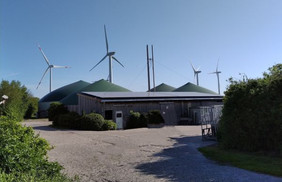Promising prospects for green natural gas through power-to-gas
Sector coupling is seen as the key to overcoming current problems of the energy transition, such as the time lag between electricity generation and demand. Researchers at BTU and Flensburg University of Applied Sciences have now tested a variant of sector coupling using the example of the Nordhackstedt site, west of Flensburg. In the community, the agricultural company Nissen Biogas GmbH & Co. KG operates a 900 kW biogas plant, two satellite CHP units (400 kW each), a local heating network, and two wind turbines with nominal outputs of 0.6 and 1.5 MWel, respectively.
The concept is intended to enable the continued operation of two wind turbines that no longer receive legally guaranteed electricity remuneration. The 20-year compensation period for the two wind turbines under the Renewable Energy Sources Act (EEG) is coming to an end - the operators will only receive exchange electricity prices for the electricity from these turbines, with which the wind turbines cannot be operated profitably in the future. To avoid having to tear them down, new business models were sought.
Researchers from the BTU's Department of Waste Management developed an idea for this around the power-to-gas (PtG) approach. PtG means the conversion of electricity surpluses into a storable, gaseous energy carrier that can be converted back into electricity in times of low wind and sun, used as a fuel or even as a chemical feedstock. Specifically, the concept calls for wind turbines to supply electricity to an electrolyzer that breaks down water into oxygen and hydrogen (H2). The biogas plant in turn supplies raw biogas, whoseCO2 content reacts with the hydrogen in a reactor to form methane (CH4, natural gas equivalent). Alternativesources of CO2 include waste gases from combustion processes or even lean gases from other industrial processes. The conversion is carried out by biological methanation in an innovative trickle bed process developed and patented at the BTU.
Specialized microorganisms, so-called archaea, produce methane under anaerobic conditions and also release heat in the process. In contrast to catalytic methanation, the process is less complex in terms of equipment, technologically very robust, insensitive to interfering substances and very easy to control. It requires neither overpressure nor high temperatures and consumes relatively little energy. Finally, the process scores with high product gas purity. The synergistic coupling with biogas plants is not only supported by the use of raw biogas as input, but also by the fact that the nutrients for the microorganisms in the trickle bed can be supplied via the liquid fermentation residues of the biogas plant and the decoupled reaction heat is available for use, for example, for fermenter heating or a local heating network.
In their implementation study, the researchers technically designed a corresponding plant combination for the Nordhackstedt site and calculated in various scenarios at what cost the methane could be produced. Decisive characteristic data for this were determined in test series in a trickle-bed test reactor at the BTU. They showed in continuous long-term operation that raw biogas is suitable as aCO2 source for biological methanation. The researchers achieved a sustained and stable methane formation rate of 7 Nm³ CH4 per m³ reaction volume per day with a methane concentration in the product gas of more than 95 percent.
The economic studies indicate that the plant can be operated economically. The prerequisite is that the legal framework conditions and the plant technology are further optimized or produced in higher quantities. The biggest cost factor is the upstream process of electrolysis for H2 supply, for which, however, falling costs are forecast.
In Nordhackstedt, farmers and researchers want to test the described concept in practice in the future; the construction of an electrolyzer and a trickle bed reactor are planned. Initially, the electricity is to be drawn only from the older of the two wind turbines; the planned connected load of the electrolyzer is 500 kWel. This will enable a partial stream of biogas from the biogas plant to be methanized. Support for the concept implementation is planned from the Dresden-based engineering service provider GICON®, which developed the trickle bed process for biological methanation together with the BTU and operates a plant in the large-scale pilot plant at the Cottbus site. Nordhackstedt would be home to the world's first continuously operated pilot plant of its kind, demonstrating biological methanation with raw biogas under practical conditions and potentially serving as a blueprint for practical plants for the provision of green natural gas. The methane provided can be compressed on site into CNG (Compressed Natural Gas) and used to fuel vehicles. For a CNG tractor with a tank capacity of 52 kg, 2200 tank fillings per year would be possible obtained from previously unused surplus electricity. This makes a driving distance of 1,050,000 km per year feasible.

